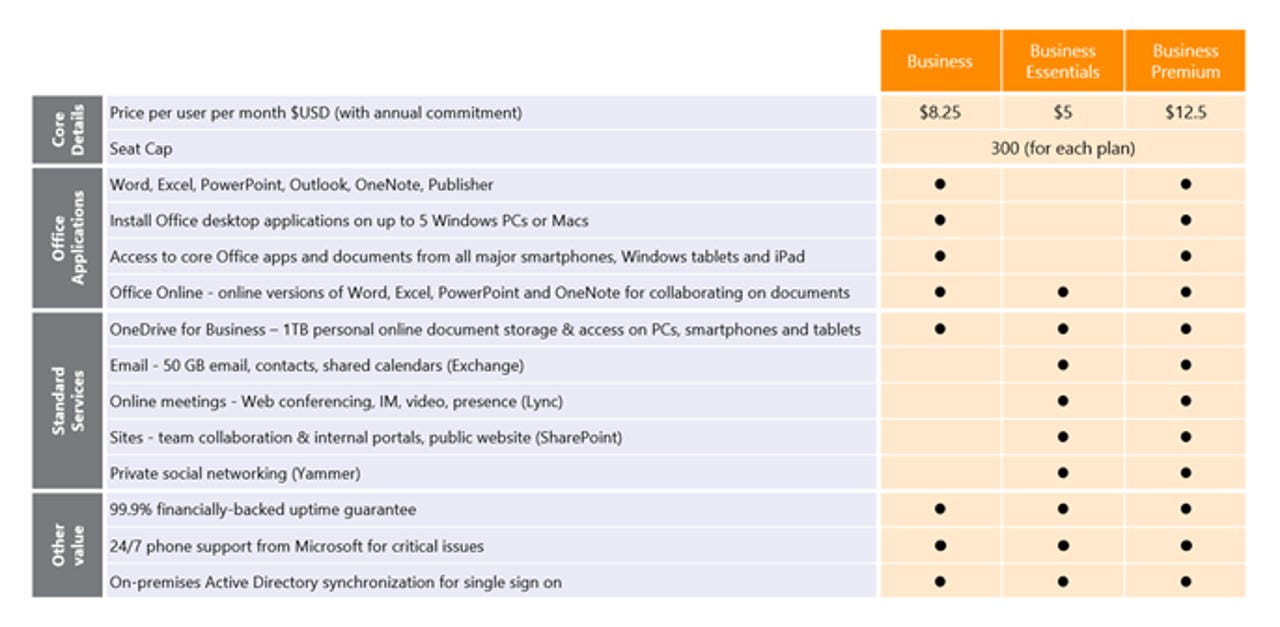Microsoft readies three new Office 365 plans for small and mid-size businesses

One of the primary markets where Microsoft goes head-to-head with Google in the office-cloud wars is the small and midsize business (SMB) space.
To shore up its offerings there, Microsoft is planning to launch on October 1, 2014, three new Office 365 plans aimed specifically at SMBs.
The three:
- Office 365 Business, which includes the full set of locally installable Office applications (Outlook, Word, Excel, PowerPoint, OneNote and Publisher) for up to 5 PCs and/or Macs per user; and 1 TB of free OneDrive for Business cloud storage. It doesn't include Exchange, Lync or SharePoint online. It's just the software (and storage) sold as a subscription. It will cost $8.25 per user per month, or $99 per year.
- Office 365 Business Essentials, which includes email and calendaring (Exchange Online); online meetings, instant messaging and video conferencing (Lync Online); team sites (SharePoint Online); 1 TB of free OneDrive for Business cloud storage, and Yammer enterprise social-networking support. It doesn't include any downloadable Office apps. It will cost $5 per user per month, or $60 per year.
- Office 365 Business Premium, which includes the full set of locally installable Office applications for up to 5 PCs and/or Macs per user; Exchange Online; Lync Online; SharePoint Online; Yammer enterprise social-networking; and 1 TB of free OneDrive for Business cloud storage. It will cost $12.50 per user per month, or $150 per year.
Here's Microsoft's chart showing how the three plans compare:

Over the next year or so, these three plans will replace Microsoft's current Office 365 plans for SMBs, which are Small Business, Small Business Premium and Midsize Business, which cost $5, $12.50 and $15 per user per month, respectively.
To ease customers into the new plans, Microsoft will begin making some of the features and pricing to existing Office 365 SMB customers this fall.
Starting October 1, Microsoft will raise the seat caps from 25 to 300 for Office 365 Small Business and Small Business Premium users. Office 365 Midsize Business users -- who already have a seat cap of 300 -- will see their prices cut from $15 per user per month to $12.50 per user per month. (Users will get the new price next time they renew, starting as of August 1, 2014.)
Users will have the option to switch more easily between plans by moving either their entire companies or just specific users. In the past, Microsoft has not allowed users to switch to a cheaper plan (only to a more expensive one). I've asked whether users will be able to downsize to a smaller/cheaper plan.
The rollout strategy for these new Office 365 plans is the most complex part of today's announcement.
Microsoft is advising existing customers that they will be able to opt-in and move to the three new plans after they launch. But the official recommendation is users just wait until their first renewal dates after October 1, 2015, given only "a small number of customers with very specific needs would realize value from moving plans" before that date, according to today's blog post.
There's also this caveat called out in today's blog post on the new plans: "Some customers will be unable to opt-in and move to the new plans immediately at launch. We are delivering an update for these customers to enable them to move to the new subscriptions by October 1, 2015." Right now, I'm not which customer set this refers to and what kind of update is needed.
Microsoft will provide more details about the new Office 365 SMB plans during its Worldwide Partner Conference in Washington, D.C., which kicks off on July 14.
At last year's partner show, Microsoft officials (and some partners) were critical of the complexity introduced by too many Office 365 options and choices. It will be interesting to see if partners think these three new plans will help Microsoft better battle Google in the cloud.